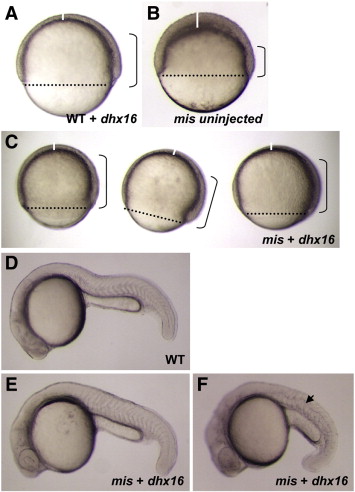Fig. 8
Rescue of the maternally mutant mis phenotype with wild-type dhx16 mRNA. (A–C) Live embryos observed at 8 h.p.f., corresponding to 75% epiboly stage in unaffected wild-type embryos. Dotted line shows the blastoderm margin, indicative of the front of epiboly; a vertical solid white line indicates the thickness of the animal-most cell layer, which normally thins out during gastrulation; and brackets demarcate the approximate extent of the involuted cell layer. (A) Wild-type embryos injected with dhx16 mRNA appear normal, shown here during gastrulation. (B) Control uninjected mis mutant embryos show morphogenetic defects characteristic of the mutation, including a reduction in epiboly, a thickened animal cap and reduced involution. (C) Three mis mutant embryos injected with dhx16 mRNA at the 1-cell stage, showing largely normal morphogenesis during gastrulation. (D–F) Live embryos observed at 24 h.p.f. (D) Wild-type embryo at 24 h.p.f. (E–F) mis mutant embryos with injected dhx16 mRNA survive gastrulation. A majority of these embryos exhibit a wild-type morphology (E), indicative of full genetic rescue. Some embryos, likely those with partial genetic rescue, survive gastrulation but have a shortened axis (F). Focal plane in (F) allows observing an abnormal undulation of the notochord (arrowhead), which may reflect remaining defects in dorsal convergence. As expected, uninjected mis mutant sibling embryos lyse during epiboly (not shown). Side views, animal pole to the top and dorsal side to the right in (A–C), and anterior to the left and dorsal to the top in (D–F).
Reprinted from Developmental Biology, 353(2), Putiri, E., and Pelegri, F., The zebrafish maternal-effect gene mission impossible encodes the DEAH-box helicase Dhx16 and is essential for the expression of downstream endodermal genes, 275-289, Copyright (2011) with permission from Elsevier. Full text @ Dev. Biol.

